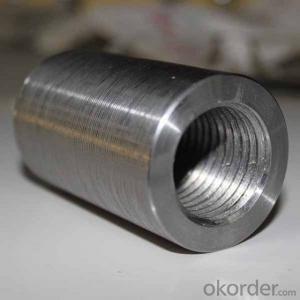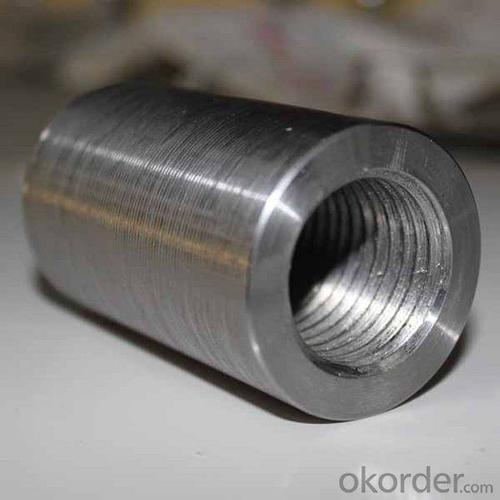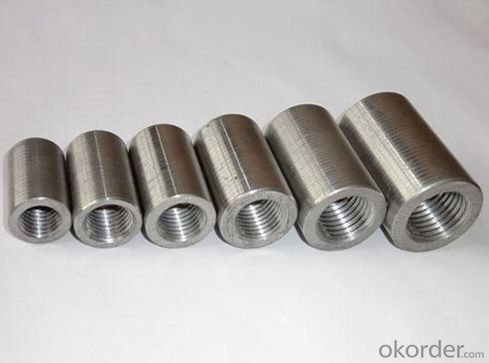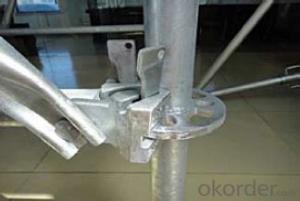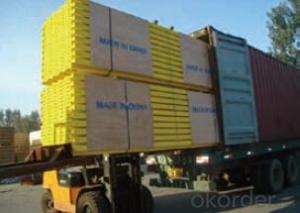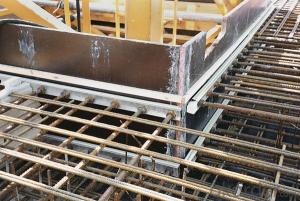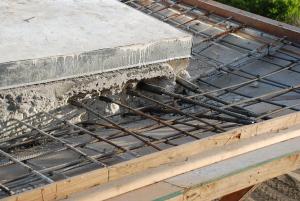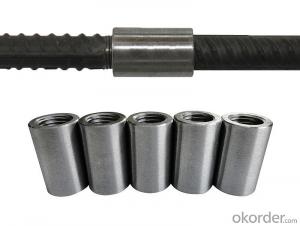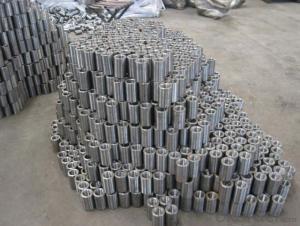Steel Coupler Rebar Scaffolding Wire Layer Scaffolding with New Design
- Loading Port:
- Shanghai
- Payment Terms:
- TT OR LC
- Min Order Qty:
- 1000 pc
- Supply Capability:
- 10000000 pc/month
OKorder Service Pledge
OKorder Financial Service
You Might Also Like
Steel Coupler Rebar Scaffolding Wire Layer Scaffolding with New Design
1.Description:
Lapped joints are not always an appropriate means of connecting rebar. The use of Steel Rebar Couplers can simplify the design and construction of reinforced concrete and reduce the amount of reinforcement required.
The threaded steel coupler system is designed as a threaded reinforcement connection with 100% load transmission. The steel coupler rebar connection system is suitable for both static and dynamic load transmission in construction joints.
The coupler is designed as a threaded reinforcement connection for formed construction joints. Reinforcement work is normally carried out on both sides of the construction joint using lap joints or one side is anchored. The bar lengths are based on the structural analysis requirements of the building component and are calculated from anchorage and lap lengths.

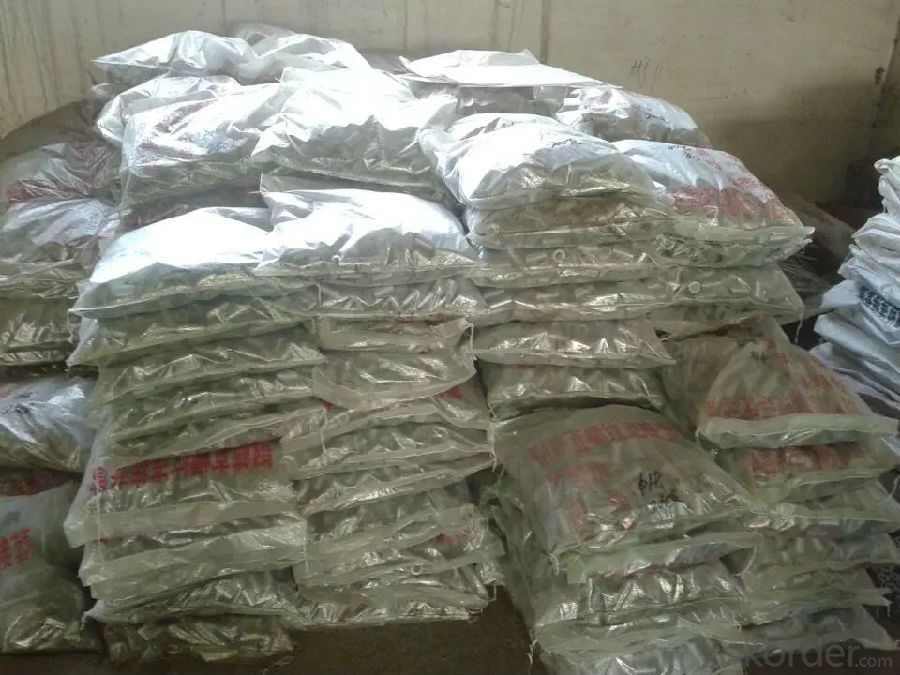
2.Advantages of Steel Coupler Rebar Lift Scaffolding Galvanized Scaffolding Tube with Low Price:
The coupler system provides the opportunity to connect rebars quickly, easily and cost effectively, even when large rebar diameters are used. This makes the steel coupler rebar range a logical extension to our rebendable CNBM reinforcement continuity system for rebars over 12 mm.
3.Available sizes of Steel Coupler Rebar Lift Scaffolding Galvanized Scaffolding Tube with Low Price:
14mm,16mm,18mm,20mm,22mmm,25mm,28mm,32mm,36mm,40mm
4.Delivery:
Delivery Term: FOB / CFR / CIF available.
Delivery Time: 15 days or less after order confirmed.
5.Why choose us?
Technical Expertise
Experienced Management
Stringent Quality Control
Exemplary Service
On-Time Delivery
Wide Product Range
Competitive Pricing
Huge branch network capable of catering worldwide
- Q: How does steel formwork handle formwork stripping and cleaning?
- The durability and strength of steel formwork make it highly suitable for formwork stripping and cleaning processes. When it comes to removing the formwork, steel formwork can be easily disassembled and taken off the concrete structure without causing any damage. This is possible because steel is inherently rigid and stable, allowing for efficient and safe stripping. In addition, steel formwork is resistant to moisture, chemicals, and other environmental factors, which makes it easier to clean and maintain. Once the formwork is stripped, any concrete residue or debris can be easily cleaned off the steel surface using appropriate cleaning techniques. This may involve using high-pressure water jets, scrubbing, or other cleaning agents, depending on the specific requirements. Furthermore, steel formwork can be reused multiple times without significant deterioration. After cleaning, the formwork can be inspected for any damages or wear and tear. Any necessary repairs or replacements can be made to ensure the integrity of the formwork for future use. Overall, steel formwork is an efficient choice for handling formwork stripping and cleaning due to its durability, strength, and resistance to environmental factors. Its easy disassembly, cleaning capabilities, and reusability make it a preferred option for construction projects where regular formwork stripping and maintenance is required.
- Q: Can steel formwork be easily disassembled and removed after construction?
- Certainly! After construction, it is possible to easily disassemble and remove steel formwork. These formwork systems are specifically designed to be reusable and offer great flexibility when it comes to assembly and disassembly. Typically, the components of steel formwork are lightweight, making them easily manageable and movable by construction workers. Furthermore, steel formwork systems often incorporate adjustable clamps and brackets, enabling swift and efficient dismantling. This not only saves time and labor costs but also permits the reuse of the formwork in future construction endeavors, making it an environmentally-friendly and cost-effective option for construction projects.
- Q: How does steel formwork contribute to the overall efficiency of concrete placement?
- The overall efficiency of concrete placement is greatly enhanced by steel formwork. Firstly, the durability of steel formwork allows it to withstand the pressure exerted by fresh concrete, ensuring that it remains intact throughout the pouring and curing process. This minimizes the need for repairs or replacements and allows the construction process to proceed smoothly without delays. In addition to its durability, steel formwork is also known for its high strength and stability. This enables the construction of larger and taller concrete structures, as the formwork can support the weight and pressure without buckling or deforming. Contractors can take advantage of this strength and stability to construct complex shapes and designs, meeting specific architectural requirements efficiently. Steel formwork also offers easy and precise assembly due to its modular nature. This allows for quick installation and dismantling, significantly reducing construction time. The standardized components ensure accurate alignment, leading to consistent and uniform concrete placement. This not only enhances efficiency but also contributes to the quality and aesthetics of the final concrete structure. Furthermore, steel formwork is reusable, unlike traditional timber formwork. This reduces material waste and saves costs as the formwork can be utilized multiple times. The ability to reuse the formwork eliminates the constant need for procurement and disposal of materials, streamlining the construction process and improving overall efficiency. Lastly, steel formwork provides a smooth finish to the concrete surface. Its rigid structure prevents any bulges or deformities, resulting in a flat and even surface. This eliminates the need for additional surface treatments, saving time and resources. The smooth finish not only enhances the aesthetic appeal but also improves the durability and longevity of the concrete structure. In conclusion, steel formwork plays a crucial role in enhancing the efficiency of concrete placement. Its durability, strength, easy assembly, reusability, and ability to provide a smooth finish make it an invaluable tool in the construction industry. Contractors can expedite the construction process, reduce material waste, and achieve high-quality concrete structures efficiently by utilizing steel formwork.
- Q: How does steel formwork prevent concrete shrinkage and cracking?
- The use of steel formwork is essential in preventing concrete shrinkage and cracking. By offering robust and rigid support during the curing process, it ensures that the concrete retains its shape and hardens properly. Acting as a mold, the steel formwork securely holds the concrete in place, preventing any shrinkage or cracking as it dries. Concrete shrinkage and cracking are primarily caused by the loss of moisture during curing. As the water evaporates from the concrete, it causes the material to shrink, potentially leading to cracks if not adequately supported. To prevent this shrinkage, steel formwork provides a tight enclosure for the concrete, ensuring that it retains its moisture and doesn't dry out too quickly. This controlled drying process allows for even curing, minimizing the risk of shrinkage and cracking. Moreover, steel formwork provides stability and support to the concrete, preventing any movement or shifting as it hardens. This stability helps distribute forces and stresses evenly, reducing the likelihood of cracking or structural failure. Furthermore, the smooth and rigid surface of steel formwork contributes to achieving a high-quality finish on the concrete. This eliminates any irregularities or imperfections that may weaken the structure or make it more susceptible to cracking. In conclusion, steel formwork is vital in preventing concrete shrinkage and cracking by offering support, stability, and moisture retention during the curing process. Its strong and rigid structure ensures the integrity of the concrete and enhances its durability, reducing the risk of structural issues.
- Q: What are the typical deflection limits for steel formwork systems?
- The typical deflection limits for steel formwork systems can vary depending on several factors, including the specific design and application requirements of the project. However, there are some general guidelines that are commonly followed. In most cases, the deflection limits for steel formwork systems are typically determined based on the span length and the load applied to the formwork. As a general rule, the deflection limits for steel formwork systems are often limited to L/360 or L/240, where L represents the span length of the formwork. For example, if the span length of the formwork is 10 feet, the deflection limit would be L/360, which equals approximately 0.028 feet or 0.34 inches. This means that the maximum allowable deflection for this formwork system would be 0.34 inches, ensuring that the formwork remains stable and does not significantly deform under the applied load. It is important to note that these deflection limits may be adjusted based on the specific project requirements or industry standards. For instance, in certain high-rise construction projects, stricter deflection limits may be imposed to ensure the structural integrity and overall safety of the formwork system. Ultimately, the deflection limits for steel formwork systems must be carefully considered and evaluated during the design and construction process to ensure the formwork can effectively support the applied loads and maintain its stability throughout the construction process. Consulting with a structural engineer or referring to relevant industry standards can provide more specific and accurate deflection limits for a given steel formwork system.
- Q: Can steel formwork be used for both above-grade and below-grade walls?
- Yes, steel formwork can be used for both above-grade and below-grade walls. Steel formwork is a versatile and sturdy option that can withstand the pressure and weight of concrete for both types of walls. It offers durability, ease of use, and the ability to create precise and smooth finishes.
- Q: How does steel formwork contribute to the overall safety of workers?
- Steel formwork contributes to the overall safety of workers by providing a sturdy and reliable structure for concrete construction. Its strength and durability minimize the risk of collapse or accidents during the construction process, ensuring the safety of workers. Additionally, steel formwork is designed to be easily assembled and disassembled, reducing the labor and time required for installation and minimizing potential hazards.
- Q: What are the considerations when designing steel formwork for elevated walkways?
- When designing steel formwork for elevated walkways, several considerations need to be taken into account. Firstly, the load capacity of the walkway must be carefully calculated to ensure it can support the intended weight of pedestrians and any additional loads such as furniture or equipment. The structural integrity of the formwork is crucial, requiring the use of high-quality steel and appropriate reinforcement to withstand the stresses and forces it will experience. Additionally, safety is a paramount consideration. The formwork must be designed to provide sufficient strength and stability, incorporating features like handrails and non-slip surfaces to prevent accidents and ensure user safety. Adequate access points and emergency exits should also be incorporated into the design. Durability is another important factor. Steel formwork for elevated walkways should be resistant to corrosion and weathering, as these structures are often exposed to various environmental conditions. Proper protective coatings and maintenance strategies should be implemented to ensure the longevity of the formwork. Lastly, the aesthetics of the walkway should be considered. The design should be visually appealing and harmonize with the surrounding environment or architectural style. Attention should be given to details such as finishes, color schemes, and integration with other elements of the overall design. Overall, the considerations when designing steel formwork for elevated walkways encompass load capacity, structural integrity, safety, durability, and aesthetics to create a functional, safe, and visually appealing structure.
- Q: Can steel formwork be used in areas with high humidity?
- Yes, steel formwork can be used in areas with high humidity. Steel is a durable material that is not easily affected by moisture or humidity. It does not absorb water like wood and does not warp, swell, or rot when exposed to high humidity levels. Steel formwork also has a smooth surface that prevents the formation of mold or mildew. However, it is important to ensure proper surface protection and maintenance to prevent any corrosion due to prolonged exposure to high humidity. Regular cleaning and applying protective coatings can help extend the lifespan of steel formwork in areas with high humidity.
- Q: How does steel formwork handle different concrete surface finishing options?
- Steel formwork is highly versatile and capable of accommodating various concrete surface finishing options with ease. Its robust structure provides excellent support, allowing for smooth finishes like polished concrete or exposed aggregate. Additionally, steel formwork can incorporate intricate patterns or textures, enabling decorative finishes such as stamped or stenciled concrete. Moreover, the durability of steel formwork ensures consistent and accurate results, regardless of the desired surface finishing option.
Send your message to us
Steel Coupler Rebar Scaffolding Wire Layer Scaffolding with New Design
- Loading Port:
- Shanghai
- Payment Terms:
- TT OR LC
- Min Order Qty:
- 1000 pc
- Supply Capability:
- 10000000 pc/month
OKorder Service Pledge
OKorder Financial Service
Similar products
Hot products
Hot Searches
